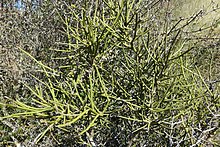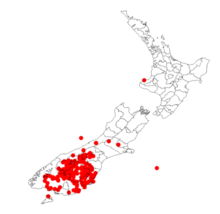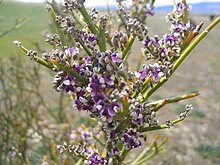
Carmichaelia is a genus of 24 plant species belonging to Fabaceae, the legume family. All but one species are native to New Zealand; the exception, Carmichaelia exsul, is native to Lord Howe Island and presumably dispersed there from New Zealand.

Clianthus, commonly known as kakabeak, is a genus of flowering plants in the legume family Fabaceae, comprising two species of shrubs endemic to the North Island of New Zealand. They have striking clusters of red flowers which resemble the beak of the kākā, a New Zealand parrot. The plants are also known as parrot's beak, parrot's bill and lobster claw – all references to the distinctive flowers. There is also a variety with white to creamy coloured flowers called: "Albus", and a variety with rosy pink flowers called: "Roseus".

Clianthus puniceus, common name kaka beak, is a species of flowering plant in the genus Clianthus of the legume family Fabaceae, native to New Zealand's North Island.

Carmichaelia carmichaeliae is a species of plant in the family Fabaceae. It is found only in South Island of New Zealand. It is classified as having the "Nationally Critical" conservation status under the New Zealand Threat Classification System.

Carmichaelia torulosa is a species of plant in the family Fabaceae. It is found only in New Zealand.

Olearia hectorii is a species of flowering plant in the daisy family Asteraceae. Its common names include deciduous tree daisy and Hector's tree daisy. It is endemic to New Zealand, where it is nationally endangered.

Melicytus is a genus of flowering plants in the family Violaceae. Hymenanthera is a synonym. It includes 19 species native to Australia, New Zealand, and the southwestern Pacific.

Donald Petrie was a Scottish botanist noted for his work in New Zealand.
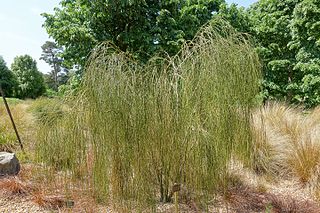
Carmichaelia stevensonii, the cord broom or weeping broom, is a species of shrubby plant in the Sweet pea subfamily (Papilionoidea) of the Bean family Fabaceae. It is found only in the north east of the South Island of New Zealand. It is threatened by habitat loss. It is a leafless shrub up to twelve feet in height. Unlike Spanish Broom the branches are of a weeping habit.

Carmichaelia muritai, common name coastal tree broom, is a species of plant in the family Fabaceae. It is found only in the South Island of New Zealand.
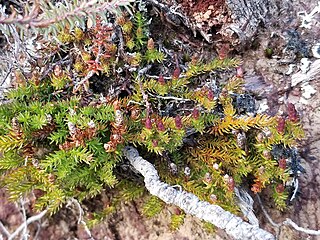
Lateristachys diffusa, synonym Lycopodiella diffusa, known as carpet clubmoss, is a species of clubmoss in the family Lycopodiaceae. It is indigenous to New Zealand and to Tasmania, Australia.

Myrsine divaricata also known as weeping māpou or weeping matipo, is a small tree up to 4 metres (13 ft) tall or often a shrub endemic to New Zealand. It has a strongly divaricating habit with interlaced branches. The woody parts are stiff and pubescent when young. The small leathery simple leaves are borne on short petioles and may be slightly two lobed at the end. The very small yellow or reddish flowers may be borne singly or in small groups which mature into small purple, occasionally white, fruit.
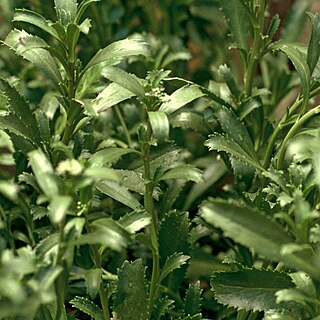
Lepidium banksii, known as coastal peppercress, is a rare species of flowering plant from the family Brassicaceae. It is endemic to New Zealand, formerly found around the coast of the northern South Island but now critically endangered.
Cerius otagensis is a species of flightless fungus weevil that is endemic to New Zealand. It has been found in only two locations in the Central Otago region.

Pseudowintera traversii, sometimes called Travers horopito, is a species of woody shrub in the family Winteraceae. The specific epithet traversii is in honor of naturalist Henry H. Travers (1844–1928), son of William Thomas Locke Travers.
Peter Brian Heenan is a New Zealand botanist.

Carmichaelia curta is a species of plant in the family Fabaceae. It is found in New Zealand. It is classified as having the "Nationally Critical" conservation status under the New Zealand Threat Classification System.
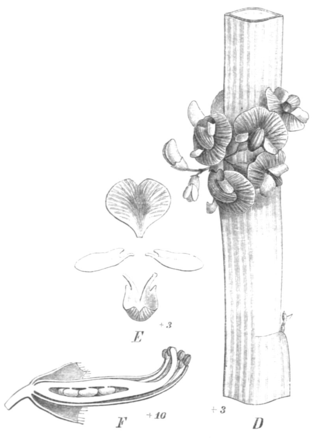
Carmichaelia australis, commonly known as the New Zealand common broom or mākaka, is a shrub of the Fabaceae family. It is native to New Zealand and found in both the North and South Islands.
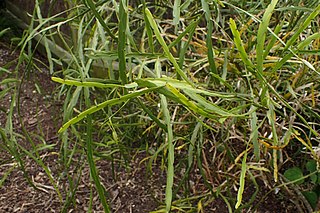
Carmichaelia williamsii is a species of plant in the family Fabaceae. It is found only in the North Island of New Zealand. Its conservation status (2018) is "At Risk (relict)" under the New Zealand Threat Classification System.
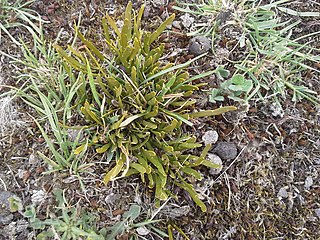
Carmichaelia corrugata is a species of plant in the family Fabaceae. It is found only on the South Island of New Zealand.
